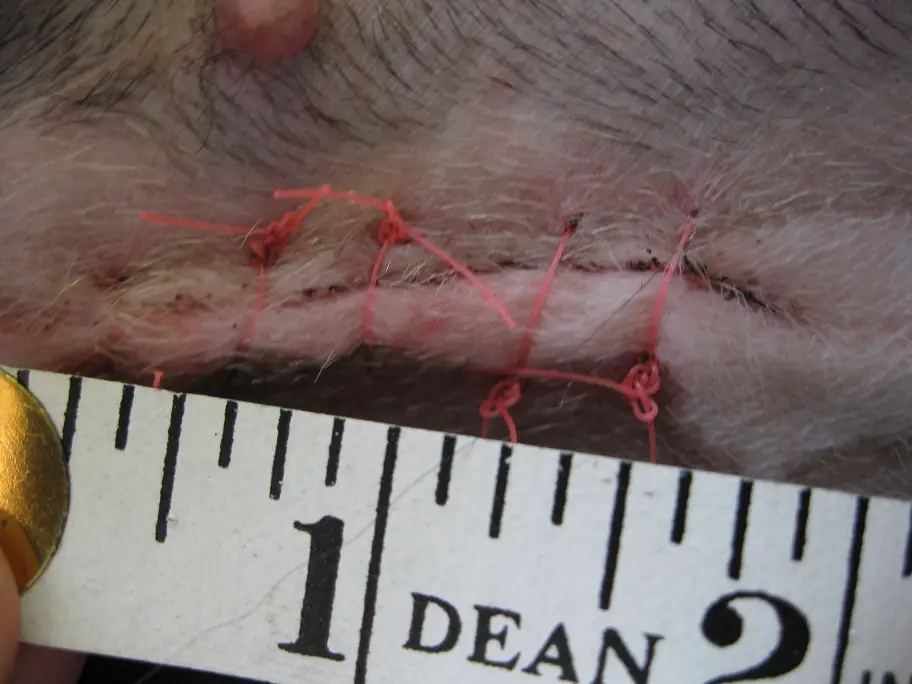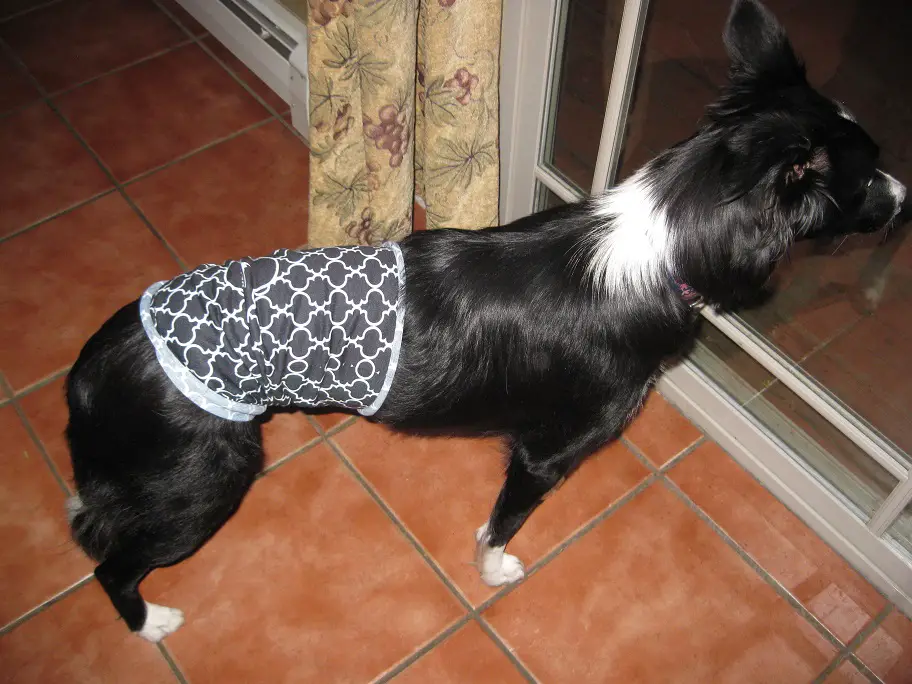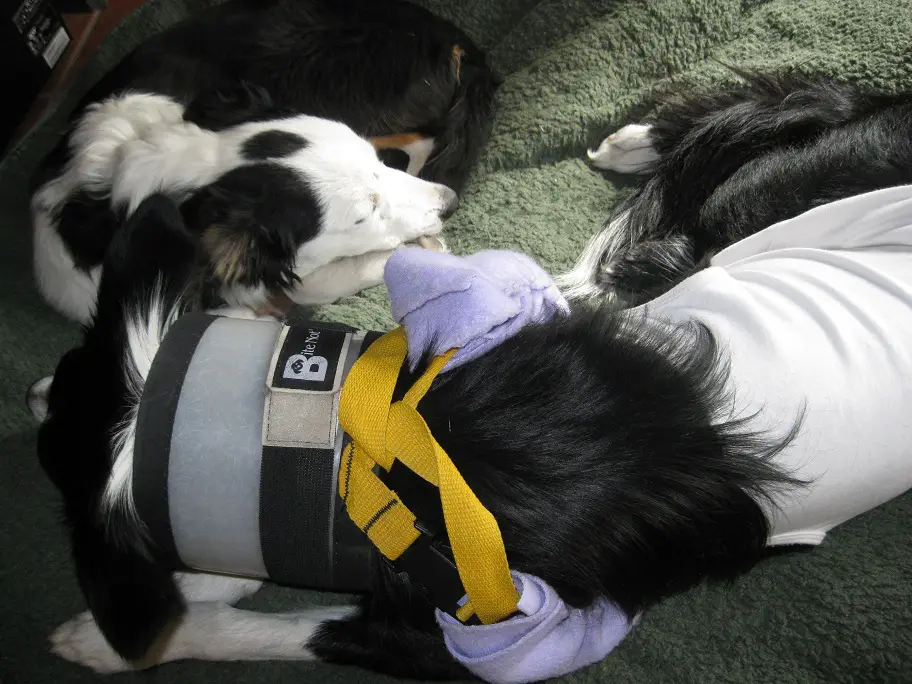When it came time to spay Clover, after letting her go through one heat cycle and waiting for her extremely LONG false pregnancy to end, I had a LOT of questions about a traditional spay versus other surgical options. I know that seems silly considering that I’ve had dogs my whole life and write professionally about veterinary medicine, but I had NOT had to have a dog spayed since 1990 (because Lilly was spayed prior to our adoption), and I didn’t know how much had changed. I wanted to make a good decision.
So, I asked my super-experienced pals about the surgeries they chose:
- Some went with a laparoscopic spay surgery.
- Some went with a laser spay surgery.
The main argument for both of those? Faster recovery.
Why I Chose a Traditional Spay
Our main veterinary hospital does NOT offer either, so that meant I would have to find somewhere else to go, if I chose either of those surgery options. I pride myself with having good, long-term relationships with our veterinary teams, and the thought of starting over with someone new for just this one thing felt daunting.
Next, I asked our veterinary neurologist (who treated our late Lilly and late Ginko) for input because long before he became board certified in veterinary neurology and neurosurgery he was also board certified in veterinary surgery.
He pointed out a few things that made a lot of sense to me:
- General practitioners do a LOT of traditional spay surgeries, and most get very good at it.
- The incisions made for a laparoscopic spay surgery when added up likely equal the same length as a good traditional spay incision.
- Plus, given the choice between really being able to SEE inside the dog and having likely less visibility through smaller holes, he would always choose being able to see — not only for the spay itself, but also for general knowledge and confirmation that all the other organs look good.
- In the end, he told me he prefers “cold, hard steel” (meaning a scalpel).
Questions to Ask
He also gave me a couple of questions to ask our main veterinary hospital before making my decision:
- Do you use electrocautery? (Especially important for Clover to lessen bleeding after all her uterus had been through and because her mammaries were still bigger than normal)
- Who will be doing the anesthesia and vitals monitoring? (Basically, you want the MOST experienced veterinary technician at the hospital on the job for your dog that day)
- I also flat out asked our main vet if she LIKED doing spay surgeries and felt like she was GOOD at it.
Other Requests
In addition, I made specific requests for:
- Pre-anesthesia blood work
- Pre-anesthesia sedatives (more specifically for Acepromazine NOT to be used)
- Serious pain control meds both at the hospital and to bring home
- Dog-calming music for Clover before and after surgery
How the Traditional Spay Went
As you can see, Clover’s traditional spay incision was quite small. It healed beautifully. Stitches were removed 2 weeks later. For Clover’s traditional spay surgery, we paid about $420.
Clover’s recovery went pretty well. She hated the cone of shame (Comfy Cone) that I bought her. She would stand looking straight at the ground and refuse to move. We went with a belly band (even though they are designed for male dogs) for a while just to protect the surgery site. She even wore it to agility class (no jumping) and did great. Heck, we even tried a stretchy buff. See below.
That worked really well for the first week, but the second week of her recovery, she started fussing at the incision a LOT, so we had to use the Bite-Not Collar and a t-shirt. Here you can see Tori snugging in solidarity. A lot of people are now using body suits or pajamas to cover surgery sites. Here are a couple of options that might work better for you. Be sure they have a belly panel.
Trying to keep BOTH puppies mellow during Clover’s recovery from her traditional spay was not easy, but we did it. (And, will need to do it again soon for Tori.) They were quite pleased when Clover got cleared by our veterinarian to return to normal activity back in October 2015.
Have you had to make a spay decision like this? What did you choose?
*** Bonus Caution ***
One quick caution. A friend of mine recently had her young border collie spayed at a “low-cost” spay/neuter clinic at an animal shelter near her home. It was a disaster. In addition to the puppy being handled roughly prior to surgery, the incision looked terrible, was sewn up with outdated metal sutures, and soon after TORE OPEN. (I would show you a photo, but it’s really awful.)
She has since filed a formal complaint with the state’s veterinary board.
A friend of mine from the animal shelter community argued with me about lumping ALL “low-cost” spay / neuter clinics together. He is right. I know many reputable shelters and humane organizations who use the same top-notch medical standards for their low-cost surgeries as they would for any of their full-payment patients.
So, instead, I tell you this story so that if you do decide to go the low-cost route, then please ask lots of questions about the medical and surgical protocols used. Know what you’re paying for, including why and how they can do it for so much less. In some cases, it’s because they do the surgeries differently. In other cases, it’s because the true cost of the surgery is subsidized in other ways.








We did a traditional spay for Elka. The stitches she had were the self dissolving kind, and while she did have a regular “lampshade” cone of shame, we didn’t use it on her after the first day unless she was unsupervised, because it just made her MISERABLE. The hard part was keeping her calm; she was both excitable and ouchy, and didn’t understand the ouchy part of it, of course. She was also a total space cadet on the pain killers they provided, so while I was happy they did provide pain medication, they didn’t provide an alternative when we didn’t like how she was on the first ones.
Oh, no! Clover’s pain meds (2 of them) seemed to keep her comfortable without making her goofy. I’m sorry to hear that Elka had a different experience and that your veterinary hospital wasn’t keen on helping you find another option. (sad face)
I think it’s going to be MUCH harder to keep Tori and Clover mellow after Tori has surgery. She was still a tiny baby puppy when Clover had her surgery, so it was pretty easy to keep Clover on leash and let Tori romp around outside. Now that they are both bigger, I think it will be harder.
This is excellent information. I am most definitely going to share this with my readers. Many thanks!
Thanks so much for posting this. I’m definitely going to share this with my readers. Many thanks!
Great info for anyone with fur-babies. Even though I don’t have a dog (#sadface), I so appreciate you sharing your experiences for those in this situation.
This is a really good post and very informative for pet parents. I would also caution against people thinking that just because it’s labeled “low cost spay clinic” that it may not have the same quality as a private veterinarian. I had two of my rescues spayed at low cost clinics offered by the Humane Society when I lived in the city and they both turned out very well. On the other hand, I had one of our rescues spayed by our vet and it nearly cost her life. The lesson here, I think, is to ask a lot of questions as you did, before any procedure is done on your fur baby.
Exactly, Kerri. We need to be asking ALL spay / neuter providers to detail their protocols and costs so that you know what you’re paying for and getting (or not getting, as the case may be). I’m extra wary now of low-cost options after what my pal went through with her dog.
This fantastic article arrives in a timely fashion for us.We have added a small black poodle to our family. Although it really was much too soon after losing Ruby Tuesday,he presented himself for consideration and so we said Yes. Raven Nevermore Shuma will be neutered soon., and so we have been looking into procedures. Thanks so much for the benefit of your research and experience,and ,as always, God Bless You All..
Oh, that’s SUCH happy news, John. I know you’re still grieving so much. With male dogs, you have so much more leeway on WHEN to do the neuter. If you can, I would recommend waiting until he is full grown. Welcome home, Raven Nevermore!
My current girl is my first female who did not come to me already spayed. I waited until she was 4 years old to spay her. Why? 1) She had breeding potential, and I didn’t decide until she was three that breeding definitely wasn’t in the cards. 2) I wanted to make sure her skeleton was fully developed and mature. I’ve done some stockdog (herding) work with her and a little bit of agility, so I wanted her growth plates to close when they should, without worrying about an early spay leading to her being taller and possibly more prone to cruciate ligament injuries than she would be if fully mature before spaying. 3) Her seasons were not all that much of a hassle for me, so leaving her endocrine system intact seemed reasonable. 4) My previous Australian shepherd was probably spayed around 6 months of age and probably before her first season. She had an enormous, hard-to-care-for spay coat. I don’t enjoy *that* much brushing! Why did I spay her at 4? 1) intact Dogue de Bordeaux over the short back fence. Those would’ve been some ugly puppies! 2) I wanted to get another dog, and having her spayed made me comfortable looking for male or female buddies for her. 3) Concerns about increasing risk of pyometra in a never-bred female.
When I did decide to spay her, I asked for local friends’ experiences with their dogs’ spays, and I asked a vet tech friend about a couple of doctors and clinics. The one I chose is not board-certified but has done many spays and has an excellent reputation as a surgeon. Costwise, our chosen vet was on the higher side, but this meant my girl was kept with heated pads under her on the table during surgery, a vet tech assigned exclusively to her anesthesia, anesthesia protocol designed for MDR1 mutants (who are more sensitive to many anesthesia agents), etc. I was surprised at how many things are not included in the price at lower-cost places and how many questions I had to learn to ask by calling clinics and talking to them.
I went with a full spay. I thought about an ovary-sparing spay because those are supposed to give the hormonal benefits of being intact without the risk of pyo, but those were not very common in my area 3 years ago. No one I found was doing ovary-only spays. She came through the spay with flying colors (they sent her home an hour or two early because she was singing loudly about how distraught she was in a cage in a strange place), the incision is small, her hair is a little longer but has not yet turned into the soft, cottony mess I feared. Later that year I did purchase a male Aussie, so I’m glad I don’t have to worry about her seasons with him around. For one thing, he is a half-brother to her mother, and we just don’t need to go there.
Thanks so much, Judi, for your detailed comment. I totally AGREE with waiting on spays / neuters until growth plates are closed (if you can) for that very reason of protecting knees from injury due to bone growth if you do the surgery too young.
I’ve not heard of a spay coat before.
And, yes, I’m not only willing to pay for but genuinely require all the best surgical protocols before, during, and after surgery.
I spent a lot of time researching this and talking to our vet. Originally I really wanted to just remove the ovaries, but my vet felt very strongly that it made sense to do a full spay to reduce the risk of uterine cancer. She acknowledges that taking just the ovaries is common in Europe but feels the risk of uterine cancer is so real and taking the uterus poses such small risks, that it made sense to her (although she was ready to refer me anywhere I wanted to go if that’s what I wanted). She also said she felt the recovery time was the same since the incisions for the ovary go through muscle which is the most painful for healing. Our vet used therapeutic (“cold”) laser on the incision after the surgery. I have never seen a canine incision that looked so good or healed so quickly and I’ve had 12 dogs in my lifetime. She was not after it at all. After a day or two it was nearly impossible to keep her from being active because she felt so good. In contrast, she developed a large cyst a day or two before the surgery which ended up likely being an allergic reaction to a bug bite. We had that removed at the same time and they did not use laser on that (since using the laser can spread it if it is cancerous and we didn’t know if it was till the lab report came back). The difference between the two incisions was striking. The spay incision healed so much more quickly and looked so much better. We waited until just before the first heat cycle to do the spay and I think we cut it pretty close but we did get it in time. Our vet wanted us to do it right before to reduce the risk of breast cancer that dramatically increases if you do even one heat cycle. I’m glad it went well for Clover!
Good points, Brette.
I should have mentioned that. Letting a female dog have one heat cycle increases the odds of breast cancer 8%, but letting her have 2 cycles … it jumps to 30%.
To fix Clover’s bladder issues by letting her go through 1 heat, we decided that 8% risk was worth it … vs a lifetime of UTIs.
This is such great info…just in case I get another dog. Yes, I’m thinking about it; it’s so hard not having one in the house!
Exciting! Congrats!
Both Zoe and Phoenix came spayed through the humane society but I might be going with a breeder for my next dog. I am looking at maybe doing an ovary sparing spay but I am really not sure yet!
I have friends who have done that, but I decided to do it the traditional way and take everything (ovaries and uterus). I was already “bucking tradition” by letting Clover fully mature. We’re still deciding on the timing for Tori. I’d like to wait as long as we can so that she is full grown, but we don’t particularly want her to go through a heat cycle (since Clover’s turned into SUCH an ordeal … even though it was the BEST decision for her health). I’m SO grateful that with both Clover and Tori that the rescue groups did NOT spay them as tiny puppies. I really wish more shelters and rescue groups offered that flexibility for really young dogs.